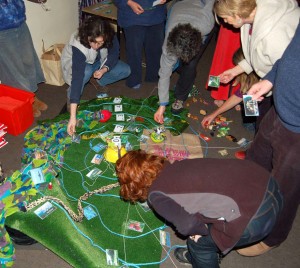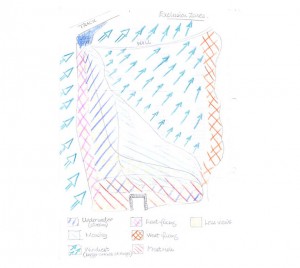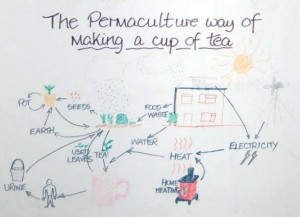by Aranya
Introduction
Now we’ll get down to experimenting with where the different elements & systems in your design might be best placed. If you already have a fixed point of focus on the site (such as a house), then you’ll be aiming to place everything most efficiently in relation to that. Most designs you do will have to work around this constraint. However, if you’re starting with a ‘blank canvas’, you also get to choose the best place to site your main point of focus. If you are arranging your design around a house or other social structure, then its placement will likely be your most important decision. If you are designing a site without an obvious central element, then you need to identify which are the most important elements to place first & go from there. Let’s look at the two cases individually.
Placement
Around an existing main element Any point of focus that is impractical to move, such as a building, may be the key constraint around which you’ll need to create your design. This being the case, we have a number of methods that we can use to most efficiently design the site. Using our base map & overlays from our site survey, we can start to plan the best placement for each element or system, using just the overlays (e.g. sectors) that are relevant in making each choice. An even better tool to help you with this overall process is the landscape modelling technique we used to understand the concepts of zones & sectors. Laying out an approximate scale model of the site on a floor or table gives us a 3D space into which we can add our systems & elements, & then explore possible relationships between them. Using such a site model, we can consider the following factors in turn to identify the best place for each system or element.
Design from patterns to details Before looking at the fine details of our design, we need to establish the overall pattern & this will be in part guided by many of the other factors that follow. It is important to adapt your overall design to the opportunities that the site offers, rather than vice versa (a common human strategy since we have used fossil fuels to power our way through everything!). You may be very excited about the idea of creating a forest garden, or growing olives, but if your site is completely inappropriate, you’ll be wasting energy & time fighting nature. For instance, hilly & mountainous regions are excellent for storing water high in the landscape, where it can then be made to do work (e.g. hydro-electric power generation or irrigation), but not so good for growing tender crops. Identify the prime opportunities your site offers & design to take best advantage of them.
Using modelling to explore placement of systems & elements on a site design
- Zoning Those systems & elements that need the most attention are best placed close to our central focus, where we spend most of our time. Use the zoning part of your site survey (maybe you created an overlay for your base map?) to consider how close each element needs to be to zone 0.
- Access & desire lines Access ways & desire lines (pathways created by people & animals) can influence the basic radial zoning pattern. Any routes walked regularly will also receive plenty of attention & can be considered zone 1 where high maintenance systems can be sited. Roads & driveways that are usually driven along, not walked are given little attention (the driver’s mind tends to be on where they are going, or what they are needing to do on arriving home). For this reason, they should be designed as low maintenance areas. Conversely, you can deliberately place high maintenance systems to create new desire lines, if they bring extra benefits to your design (e.g. making ducks walk from the duck house through the vegetable garden to the pond every day).
- Sectors For each system or element, we also need consider how they might interact with incoming energies, such as sunlight, water or wind. We place them to either harvest those energies, or to protect other elements from them. It’s important not to block low winter sunlight into buildings, so the winter sun sector is best kept clear of anything that is either already tall or that will grow to be later. The building is also best protected from both prevailing & cold winter winds. Sometimes a compromise has to be made between allowing light in & cutting wind down. How does each system or element modify noise, good & bad views, pollution etc.? Most sectors, though not all, are ‘pie’ shaped – frost for instance will gather in dips in the ground, or at the bottoms of slopes & may appear anywhere on the site. If there is a nearby watercourse, there may also be a flood sector, which could limit what you site there. Considering the optimum direction from the central building, along with the zone (distance away) & a system’s access needs, can pretty much determine it’s ideal spot…
- Elevation planning & aspect However, there are a couple of other things to consider. Firstly, returning to the idea of designing from patterns to details, we find very different microclimates, opportunities & limiting factors at the different points on a slope. There are specific strategies that work best at each point on a slope, such as trees to stabilise steep gradients & food growing slightly up the slope from the frost line in the valley bottom. The aspect of a slope is also a factor to consider. For instance, the growing conditions near the top of a sun-facing slope equate roughly to those at the bottom on the other side of the hill. In other words, the extra sun compensates for the downsides of a higher altitude.Also, which of your design elements need to be arranged in relation to slope? If you want anything to flow under the power of gravity, through a system from element to element, you need to place them at the correct relative heights. To move water from your roof guttering, into a raised tank, then a toilet cistern & on to a septic tank & reed bed system, each one needs to be placed below the previous. Water can be pumped back up hill against gravity using technologies such as the hydraulic ram, but it’s simpler to work with gravity as much as you can. Similarly, a solar hot water panel needs to be placed below the hot water storage tank in order to take advantage of the thermo-syphon effect & remove the need for a pump.
- Soil type It’s also worth remembering that when considering plants & trees, growing them in the right soil type is also important. The previous factors may have pointed to growing a particular tree in a given place, but if the soil is inadequate, or the wrong type, you may need to think again.
- Succession Nature never stands still. Trees grow. Rivers change their course. These things may take time, but depending upon the timescale of your design, they may be things that you need to consider too.
The blank canvas
From time to time you’ll find yourself designing a ‘blank canvas’, so you need to know how best to proceed. In such cases, without an existing central element around which to identify any zones, you need to give more consideration to the other factors mentioned above in determining the best place around which to focus your design. You may also find the following technique useful in deciding where to place zone 0:
McHarg’s exclusion method As well as being a useful tool for placing fussy elements that are adversely affected by multiple factors, the exclusion method can help us to site our most important elements, like our zone 0 structure. By systematically eliminating sectors that are clearly not best suited, we can quickly narrow down our options & make it simpler to identify our ideal site. If we also look at how our systems & elements are going to integrate together (our next consideration), we can then also eliminate any areas unsuited to those systems & elements that will integrate with zone 0. For example, if we wish to have a spring feed water under gravity into our home, then we clearly have to eliminate the area above the level of the spring from our considerations.
The Exclusion method used to find the best place for fruit trees on an Irish mountainside.
Integration
So having placed all our systems & elements where they each appear to work best, we’ll now look at how they could be integrated together & if that might suggest a better layout. Creating plenty of beneficial relationships will endow your design with resilience & efficiency, so look to connect your systems & elements together wherever you can. Again, there are a number of tools that we can use to guide us in making these decisions.
Energy cycling As any form of external energy moves through our site, we should be designing to make best use of it. To do this we link together elements to create systems. The simplest link is where each element takes as inputs, the outputs of previous ones. This simple chain can reuse a resource like water several times, before it leaves the site (in a non-polluting manner of course). We can also create cycles where nutrients are continually cycled around our systems, building fertility or storing a surplus of energy as it goes.
A simple cycling system to reduce work & minimise pollution
- Guilds Placing several elements together where each can benefit the others indifferent ways is another useful strategy. We see guilds everywhere in nature, because when seeds fall near other beneficial plants they grow much more abundantly. Some cultures still grow their crops using guilds, like the Central American ‘three sisters’ of corn, beans & squash. The bean fixes nitrogen that benefits the other two, the corn provides a structure for the bean to climb & the squash covers the ground, protecting the soil & keeping in moisture.
Edge effect We know that the boundary between systems is a fertile place, so we can exploit this to get greater yields. Guilds work on this principle, though for each benefit, there is a given distance apart where the effect becomes negligible. Placing systems together will provide you with opportunities, so it is just a case of deciding which edges you want & where you want them. This effect can be exploited further, by identifying that critical distance & creating a new edge each time it is reached. Wheat can be grown in strips with (nitrogen fixing) alfalfa so that each plant benefits from close enough proximity to the other (the width of the strips is important). This system can yield as much wheat grain as if the whole field had been used to grow it & produce a bonus alfalfa fodder crop too.
Strip farming, utilising the beneficial edge effect
- Alley cropping & matrix planting The edge effect is also utilised in designing agroforestry alley cropping systems. Again, the strips are no more than a particular width to take full advantage of the beneficial relationships between neighbours. Several crops may be grown together, so we also arrange them to minimise antagonistic relationships. Any two species that don’t grow well together can be separated by another that benefits them both. In addition any lines of trees may be part of a swale or a windbreak system, so consideration needs to be given to interaction with slope & sectors. While designing beneficial relationships in alley cropping focuses in just two directions (the rows either side of any given one), the edge effect in more complex production systems like forest gardens adds in another dimension. Any element (e.g. plant or tree) in the design will have other species around it in multiple directions. This makes laying them out (matrix planting) more complicated, but the same idea applies of finding species to intervene beneficially between species with less than ideal interactions.
- Biological control Sometimes though you might integrate elements to deliberately suppress the growth of one of them. This is biological control & you may use it to naturally reduce pest or weed populations on the site.
- Patterns As well as identifying the overall design of the site, we can use patterns to help us integrate elements into systems. Where are the desire lines (where people & animals like to walk)? What tasks are routinely carried out together & can they be integrated with each other around these lines? What is already working well together? Play around with placing systems & elements in your design until it feels like you have created the most effective layout. If you can, get feedback from your clients or other designers at this point before committing your ideas to paper (or camera).
And onto the final design drawing stage… OK, we’re nearly there! All we need to do now is to get your ideas down onto a final design drawing that you can present to your client (part 7). Go to part 7 - Design drawing
- Log in to post comments




